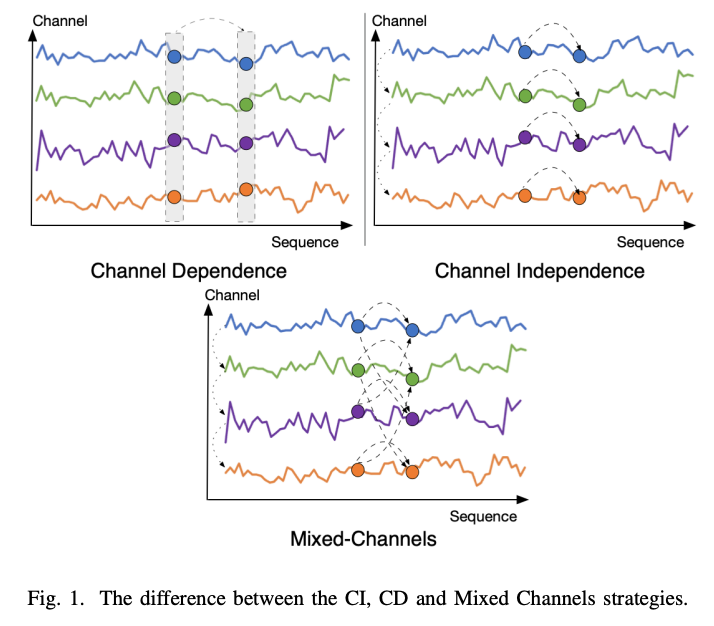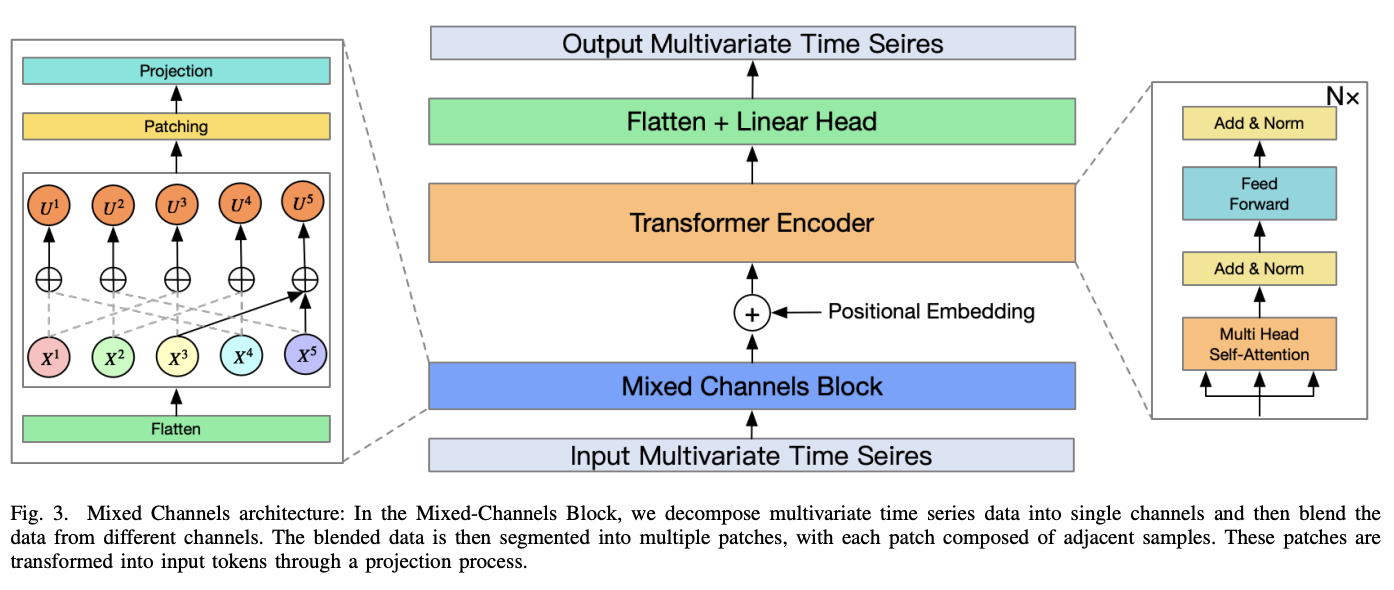MCformer: Multivariate Time Series Forecasting with Mixed-Channels Transformer
Contents
- Abstract
- Introduction
- Method
0. Abstract
Channel Dependence (CD)
- Treats each channel as a univariate sequence
Channel Independence (CI)
- Treats all channels as a single channel
- Challenge of interchannel correlation forgetting
MCformer
(MTS forecasting model with mixed channel features)
- Innovative Mixed Channels strategy
- Combine the
- (1) Data expansion advantages (of the CI strategy)
- (2) Ability to counteract inter-channel correlation forgetting
- Details:
- Blends a specific number of channels
- Attention mechanism to effectively capture inter-channel correlation information
1. Introduction
Success of the CI strategy
- DLinear: has surpassed existing models !
- PatchTST: CI strategy model
- Expanding the dataset and enhancing the model’s generalization capability
Research on PETformer
- CI > CD, because multivariate features can interfere with the extraction of long sequence features.
- This result goes against intuition, as in DL, more information typically improves model generalization.
Two main reasons why CI >CD
- Can expand the dataset to improve the generalization performance of the model ( feat. PatchTST )
- Can avoid the destruction of long-term feature information by channel-wise correlation information ( feat. PETformer )
Drawbacks of CI strategy
- Overlook inter-channel feature information
- With large # of channels, there may be an issue of inter-channel correlation forgetting
Mixed Channels strategy
- (CI) Retains the advantages of the CI strategy in expanding the dataset
- (CD) Avoiding the disruption of longterm feature information by channels.
- Addresses the issue of inter-channel correlation forgetting.

MCformer
- Multi-channel TS forecasting model with mixed channel features.
- Procedure
- Step 1) Expands the data using the CI strategy
- Step 2) Mixes a specific number of channels
- Step 3) Attention mechanism
- Capture the correlation information between channels
- Step 4) Encoder result is unflattened to obtain the predicted values of all channels

2. Method
(1) Problem Definition
Input: \(X=\left\{\mathbf{x}_1, \mathbf{x}_2, \ldots, \mathbf{x}_t\right\} \in \mathbb{R}^{t \times M}\),
- \(\mathbf{x}_t=\left[x_t^1, x_t^2, \ldots, x_t^M\right]^{\top}\).
Target: \(\left\{\mathbf{x}_{t+1}, \ldots, \mathbf{x}_{t+h}\right\}\)
Incorporate a Mixed-Channels Block into the vanilla Transformer Encoder
- to expand the dataset
- to blend inter-channel dependency information

(2) RevIN
Reversible Instance Normalization (RevIN)
- Address the issue of distribution shift.
Before the Mixed Channels module, we apply RevIN to normalize each channel’s data.
Notation
- Single channel : \(\mathbf{x}^i=\) \(\left[x_1^i, x_2^i, \ldots, x_t^i\right]\),
- For each instance \(x_t^i\), calculate statistics
- \(\operatorname{RevIN}\left(\mathbf{x}^i\right)=\left\{\gamma_i \frac{\mathbf{x}^i-\operatorname{Mean}\left(\mathbf{x}^i\right)}{\sqrt{\operatorname{Var}\left(\mathbf{x}^i\right)+\varepsilon}}\right\}, i=1,2, \cdots, M\).
(3) Mixed-Channels Block
a) Flatten
Channel Independent (CI) strategy to flatten
\(X_F=\) Flatten \((X) \in \mathbb{R}^{t M \times 1}\).
- Treated as if it were \(M\) individual samples.
b) Mixed Channels
Combining data from different channels
Procedure
-
Step 1) Compute Interval Size \(\left\lfloor\frac{M}{m}\right\rfloor\)
- where \(m\) is the number of channels to be mixed.
-
Step 2) Mixed Channels Operation:
-
For a given time step \(t\),
starting from the target channel,
stack every other channel at an interval stride to form \(U^i \in \mathbb{R}^{t \times m}\).
-
\(\begin{aligned} U^i & =\text { MixedChannels }\left(\mathbf{x}^i, m\right) \\ & =\left[\operatorname{stack}\left(\mathbf{x}^i, C^1, C^2, \ldots, C^m\right)\right] \end{aligned}\).
- where \(C^i\) represents the \(i\)-th channel taken at the \(i\)-th interval,
- and \(1 \leq i \leq m\).
c) Patch and Projection
\(\mathcal{P}^i=\operatorname{Projection}\left(\operatorname{Patch}\left(U^i\right)\right)\).
- \(\mathcal{P}^i \in \mathbb{R}^{P \times N}\),
- \(P\) : length after projection
- \(N\) : number of patches
- \(N=\left\lfloor\frac{(L-p)}{S}\right\rfloor+2\),
- \(p\) : patch length
- \(S\): stride
Details
- [Patching] To aggregate the sequence after mixing channels
- [Projection] Single-layer MLP to project channel dependencies as well as adjacent temporal dependencies.

(4) Encoder
native Transformer encoder
- does not explicitly model the sequence’s order
\(\rightarrow\) Learnable additive positional encoding \(\mathcal{W}_{\text {pos }} \in \mathbb{R}^{P \times N}\).
\(\mathcal{X}_{i n}^i=\mathcal{P}^i+\mathcal{W}_{\text {pos }}\).
pass
(5) Pseudocode

